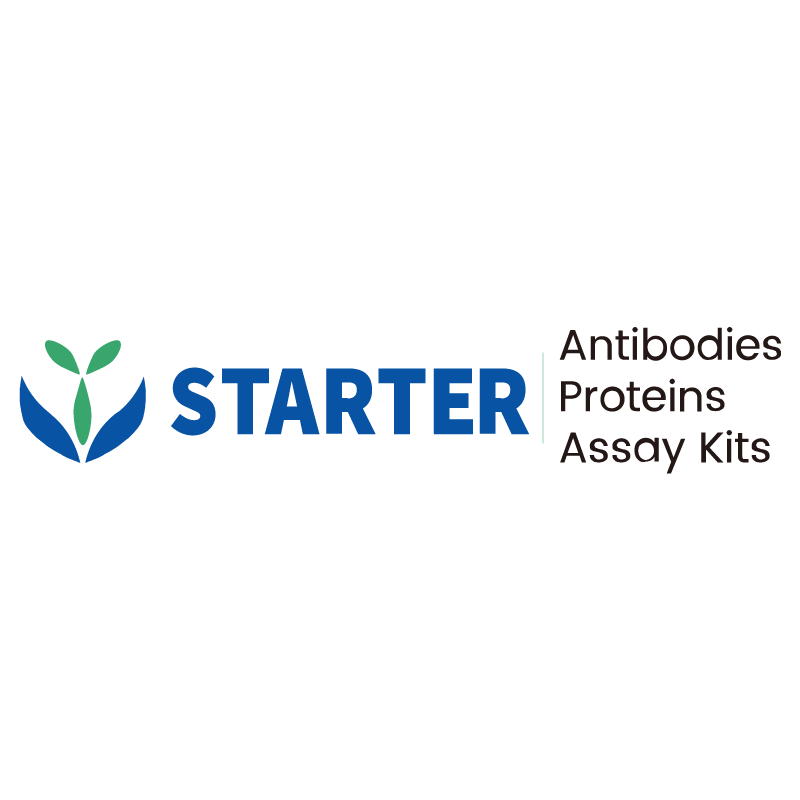WB result of 14-3-3 zeta Recombinant Rabbit mAb
Primary antibody: 14-3-3 zeta Recombinant Rabbit mAb at 1/1000 dilution
Lane 1: HeLa whole cell lysate 20 µg
Lane 2: SH-SY5Y whole cell lysate 20 µg
Lane 3: Jurkat whole cell lysate 20 µg
Secondary antibody: Goat Anti-rabbit IgG, (H+L), HRP conjugated at 1/10000 dilution
Predicted MW: 28 kDa
Observed MW: 25 kDa
Product Details
Product Details
Product Specification
| Host | Rabbit |
| Antigen | 14-3-3 zeta |
| Synonyms | Protein kinase C inhibitor protein 1 (KCIP-1); YWHAZ |
| Immunogen | Recombinant Protein |
| Location | Cytoplasm, Melanosome |
| Accession | P63104 |
| Clone Number | S-1092-31 |
| Antibody Type | Recombinant mAb |
| Isotype | IgG |
| Application | WB, IHC-P, ICC |
| Reactivity | Hu, Ms, Rt |
| Positive Sample | HeLa, SH-SY5Y, Jurkat, NIH/3T3, rat brain |
| Predicted Reactivity | Cw, Ck, Sh, Fr |
| Purification | Protein A |
| Concentration | 2 mg/ml |
| Conjugation | Unconjugated |
| Physical Appearance | Liquid |
| Storage Buffer | PBS, 40% Glycerol, 0.05% BSA, 0.03% Proclin 300 |
| Stability & Storage | 12 months from date of receipt / reconstitution, -20 °C as supplied |
Dilution
| application | dilution | species |
| WB | 1:1000 | Hu, Ms, Rt |
| IHC-P | 1:500 | Hu, Ms |
| ICC | 1:500 | Hu, Ms |
Background
The 14-3-3 zeta protein, also known as YWHAZ, is a member of the 14-3-3 protein family, which consists of highly conserved acidic proteins with molecular weights ranging from 28 to 33 kDa. The 14-3-3 zeta protein plays a significant role in cells, participating in the regulation of many key cellular life activities, including metabolism, cell cycle, cell growth and development, cell survival and apoptosis, and gene transcription. Moreover, the 14-3-3 zeta protein is closely associated with the occurrence and development of various diseases, especially neurological disorders and cancers. In cancers, the expression level of 14-3-3 zeta protein is correlated with poor patient prognosis, including breast cancer, lung cancer, multiple myeloma, head and neck cancer, and glioblastoma, among others. The 14-3-3 zeta protein is also related to chemoresistance in tumors, with its overexpression increasing the resistance of tumor cells to chemotherapy drugs.
Picture
Picture
Western Blot
WB result of 14-3-3 zeta Recombinant Rabbit mAb
Primary antibody: 14-3-3 zeta Recombinant Rabbit mAb at 1/1000 dilution
Lane 1: NIH/3T3 whole cell lysate 20 µg
Secondary antibody: Goat Anti-rabbit IgG, (H+L), HRP conjugated at 1/10000 dilution
Predicted MW: 28 kDa
Observed MW: 25 kDa
WB result of 14-3-3 zeta Recombinant Rabbit mAb
Primary antibody: 14-3-3 zeta Recombinant Rabbit mAb at 1/1000 dilution
Lane 1: rat brain lysate 20 µg
Secondary antibody: Goat Anti-rabbit IgG, (H+L), HRP conjugated at 1/10000 dilution
Predicted MW: 28 kDa
Observed MW: 25 kDa
Immunohistochemistry
IHC shows positive staining in paraffin-embedded human tonsil. Anti- 14-3-3 zeta antibody was used at 1/500 dilution, followed by a HRP Polymer for Mouse & Rabbit IgG (ready to use). Counterstained with hematoxylin. Heat mediated antigen retrieval with Tris/EDTA buffer pH9.0 was performed before commencing with IHC staining protocol.
IHC shows positive staining in paraffin-embedded human breast cancer. Anti- 14-3-3 zeta antibody was used at 1/500 dilution, followed by a HRP Polymer for Mouse & Rabbit IgG (ready to use). Counterstained with hematoxylin. Heat mediated antigen retrieval with Tris/EDTA buffer pH9.0 was performed before commencing with IHC staining protocol.
IHC shows positive staining in paraffin-embedded human colon cancer. Anti- 14-3-3 zeta antibody was used at 1/500 dilution, followed by a HRP Polymer for Mouse & Rabbit IgG (ready to use). Counterstained with hematoxylin. Heat mediated antigen retrieval with Tris/EDTA buffer pH9.0 was performed before commencing with IHC staining protocol.
IHC shows positive staining in paraffin-embedded mouse cerebral cortex. Anti- 14-3-3 zeta antibody was used at 1/500 dilution, followed by a HRP Polymer for Mouse & Rabbit IgG (ready to use). Counterstained with hematoxylin. Heat mediated antigen retrieval with Tris/EDTA buffer pH9.0 was performed before commencing with IHC staining protocol.
Immunocytochemistry
ICC shows positive staining in HeLa cells. Anti-14-3-3 zeta antibody was used at 1/500 dilution (Green) and incubated overnight at 4°C. Goat polyclonal Antibody to Rabbit IgG - H&L (Alexa Fluor® 488) was used as secondary antibody at 1/1000 dilution. The cells were fixed with 100% ice-cold methanol and permeabilized with 0.1% PBS-Triton X-100. Nuclei were counterstained with DAPI (Blue). Counterstain with tubulin (Red).
ICC shows positive staining in NIH/3T3 cells. Anti-14-3-3 zeta antibody was used at 1/500 dilution (Green) and incubated overnight at 4°C. Goat polyclonal Antibody to Rabbit IgG - H&L (Alexa Fluor® 488) was used as secondary antibody at 1/1000 dilution. The cells were fixed with 100% ice-cold methanol and permeabilized with 0.1% PBS-Triton X-100. Nuclei were counterstained with DAPI (Blue). Counterstain with tubulin (Red).


